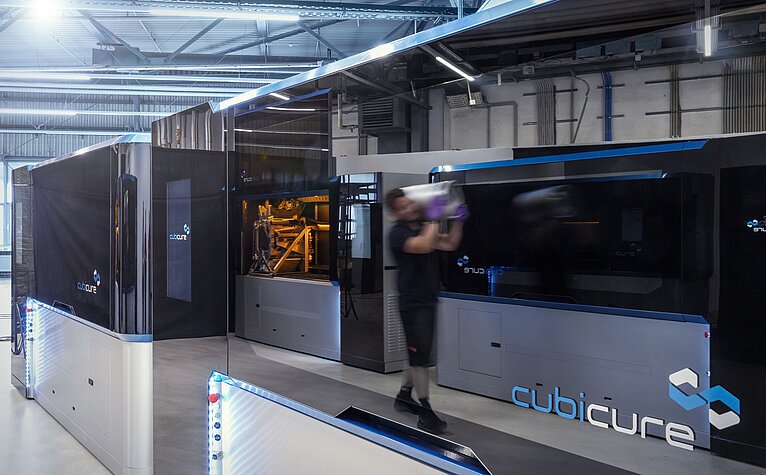 © Cubicure
© Cubicure
- Location advantages
- Life Sciences
- Success story
- Research & development
Takeover of TU Wien spin-off Cubicure by Align Technology confirms Austria's research spirit and attractiveness as a high-tech location
11. April 2024Cubicure is a true pioneer in the development of advanced 3D printing systems which also enable the manufacturing of medical devices. The two founders - Robert Gmeiner and Jürgen Stampfl – explain how the successful spin-off Cubicure emerged from a research idea at the Vienna University of Technology and why Austria was the perfect location for establishing the company. Gmeiner and Stampfl also report on the benefits expected from the acquisition of Cubicure by Align Technology in early 2024. The US company is currently the largest global user of industrial 3D printing technology.
Questions posed to Robert Gmeiner, Managing Director & CTO and Jürgen Stampfl, Co-Founder
Both of you conducted research at the Vienna University of Technology. How did the spin-off and founding of Cubicure come about in March 2015?
The successes we had with Lithoz GmbH, our first startup, comprised the underlying motivation for also taking new approaches in 3D printing with respect to polymers. Intellectual property was developed in the field of hot lithography at the Vienna University of Technology over a period of several years. Launching a company was a possibility to commercially leverage the resulting intellectual property (e.g., patents, know-how) in the long-term via licensing to Cubicure.
How would you describe the business activities of Cubicure?
Cubicure offers 3D printers as well as materials for these 3D printers. The materials (polymers) are optimised for applications in medical technology, electronics, and mechanical engineering.
What is so special about your 3D printing systems and the patented “Hot Lithography technology” and where is it used?
Hot Lithography enables the processing of highly viscous photopolymers at increased temperatures. In this way, it is possible to make use of materials in light-curing 3D printing with significantly improved structural features (strength, fracture toughness) as well as an improved functionality (e.g., biocompatibility, optical properties) compared to current state of the art materials. In this way, industrially usable components can be manufactured.
How would describe the 3D printing industry in Austria at present? What were the main developments in the last five years and in which direction is the sector heading?
The first applications in 3D printing involved the manufacturing of prototypes for small batches and product development. This market is currently very well supplied by service providers and is only growing at a slow rate. Future growth will mainly be generated by industrial applications where larger quantities or personalised products are required. In the plastics segment, in which Cubicure operates, the main growth markets worth mentioning are in the fields of biomedical engineering (e.g., restorative dentistry, orthodontics, patient-specific implants, printed organs and organoids, microfluidics) as well as the electronics industry (e.g., miniaturised components, connector technology). In the field of metallic materials, the aviation and aerospace industries as well as the defence industry are becoming increasingly important.
When you look back, how do you see the takeover by Align Technology?
The takeover is a great success story and shows that Austrian universities develop technologies which are internationally recognised and respected. Furthermore, it is also a very good example of successful Austrian entrepreneurship, especially in the deep tech field. Cubicure succeeded in commercialising the underlying technological concept, further developing core technologies as well as building up staff expertise in Austria within just a few years. Cubicure products are primarily being successfully marketed in Europe and the USA. As a result, the company has been able to grow, predominantly through its own efforts and in an economically successful manner. The current integration of Cubicure in the Align Technology group, which is the largest worldwide user of industrial 3D printing technology, will be very helpful in globally rolling out the Hot Lithography technology and further scaling it.
What kind of support did you get and how did ABA help you?
ABA’s support plays a major role, above all in making the business location of Austria even more attractive. Austria has quite a lot to offer, as a R&D location as well as a production location for high-tech machines and materials. The ABA team supports us in making these advantages visible and measurable for our American investors.
What do you think are the three main competitive advantages Austria has compared to other business locations, especially with respect to 3D printing?
A professional environment for 3D printing startups has emerged in Austria in recent years, especially with respect to spin-offs of the Vienna University of Technology. Numerous foreign investments in this field show that Austria is internationally perceived as a trendsetter. Moreover, the technical and business know-how needed to industrialise such nascent new technologies is generally available in Austria. Ultimately, high-tech made in Austria can also be among the best in the world by joining forces with international partners offering scalable business models and the necessary access to capital.
